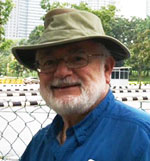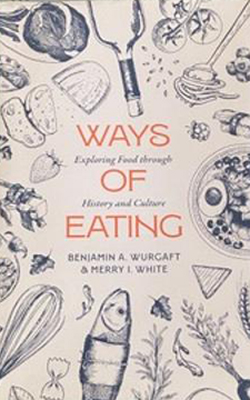Ways of Eating, Exploring Food through History and Culture by Benjamin A. Wurgaft and Merry I. White (Berkeley: University of California Press, 2023)
By Oliver B. Pollak

 TETON VILLAGE, Wyoming – Omnivore Books on Food in San Francisco was opened by Celia Sack on November 1, 2008. It is Northern California’s premier cookbook store.
TETON VILLAGE, Wyoming – Omnivore Books on Food in San Francisco was opened by Celia Sack on November 1, 2008. It is Northern California’s premier cookbook store.
Her stock includes deliciously vintage and antiquarian volumes, many signed by the authors and owners. Omnivore emails a monthly newsletter announcing forthcoming book signings. We started attending in 2010, and despite crossing the San Francisco Bay, traffic and tight parking, became devotees. Of course, the pandemic stopped that.
We made our post pandemic debut on March 18, 2024 to hear Benjamin A. Wurgaft and his mother Merry I. White present their new book Ways of Eating, Exploring Food through History and Culture.
Merry I. White, studying modernization in Japan, earned her doctorate at Harvard in 1980. Her mentors included Julia Child and Elizabeth David. Among her publications is Coffee Life in Japan (2012). Her son and coauthor Benjamin earned his doctorate at the University of California in 2009 studying 20th century Jewish intellectuals Hannah Arendt, Leo Strauss and Emmanuel Levinas. Benjamin published Jews at Williams: Exclusion, and Class at a New England Liberal Arts College in 2013. In 2020 he published Meat Planet: Artificial Flesh and the Future of Food.
Ways of Eating does not contain recipes. Instead it is packed with “takeaways” that illuminate food culture. For instance, “restaurant” derives from the “restoratives” of broth served at inns to travelers. The chapter “Medieval Tastes,” aka middle ages, presents a spirited discussion of periodization and geography.
The printing press created a burgeoning cookbook genre. The moving of sweets, puddings, and desserts to the end of the meal, reminded me of my English childhood and my mother serving “afters.”
The Hebrew Bible mentioned 29 edible plants, an 11th to 7th century BCE Chinese source
identified 45. Dietary laws identified religions and denominations. “Christians had distinguished themselves from Jews by avoiding Jewish dietary practices. Where Jews rejected certain animals as un-kosher, kept meat and milk dishes apart, and observed careful methods of slaughtering the animals they did eat, Christians held that spiritual life was not dependent on ritual concerns.”
Your reviewer adds that disagreements about Kashrut contributed to the creation of Jewish denominations. The emergence of Islam introduced Halal.
The nine chapters are separated by amusing one- to four-page vignettes, akin to an amuse-bouche or getting a nibble at intermission. The maxim “Travel was the road to culinary novelty” is demonstrated by jaunts of personal experiences, focusing on subjects as Kimchi, Panama’s Gesha coffee, and nem. The amazing spread of Vietnamese cuisine in America is exemplified by the recipe for nem, fresh spring rolls wrapped in translucent rice paper, transported from French Indochina via French Senegalese colonial troops to Boston.
In 2022 Berkeley’s Aurora Theatre featured Colonialism Is Terrible, But Pho is Delicious, a play about food appropriation by playwright Dustin Chinn.
The authors are also playful, “One of your authors, spent many hours in the early 1960s
searching for cranberries in Paris” to serve with a Thanksgiving Turkey, a tale dating from before the joint author’s birth. They expose the contested ground of how to eat peas, mulligatawny soup, curry, tooth-picking in public, the use of left and right hands, Japanese knives, and so many other things we take for granted.
Water, climate, animal husbandry, crops, land ownership and food have a long history stretching from archeology to GMO, genetically modified organism. The authors apply intelligent inquiry and observation to “the questions that food and drink can compel us to ask.”
Food origin and creation stories include the words first, indigenous, national, regional, traditional and authentic. The authors argue food styles and cuisines are a blend of travelers bringing seeds, plants, flavors, and especially spices over great land and oceanic distances, much of it the result of imperialism, colonialism and enslavement. The Columbian Exchange (1972) by Alfred Crosby identifies maize, potatoes, tomatoes and tobacco going from the New World to the Old, and the West wreaked devastating havoc on autochthonous populations of the Americas.
GastroObscura’s claim that 69 percent of the global diet is “foreign” suggests culinary borrowing and fusion.
The authors modestly conclude, “We think of this book as a toolkit for the study of food, rather than a complete catalogue of human foodways.” They provide a map for future research. The contents are a menu. The endnotes and bibliography provide intellectual sources. The Index misses textual references to Bible, cashews, Islam, porridge, rationing and other items. This book needs to be read and digested. Congratulations are in order for mother and son and the 81st volume of California Studies in Food and Culture program started in 2000.
*
Oliver B. Pollak, Ph.D., J.D., professor emeritus of history at the University of Nebraska at Omaha, a lawyer, a member of the Institute for Historical Study, is a correspondent based in Richmond, California.